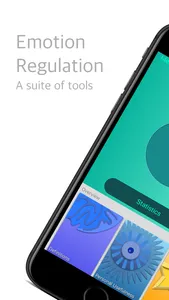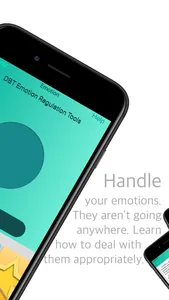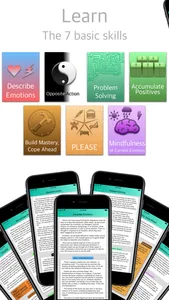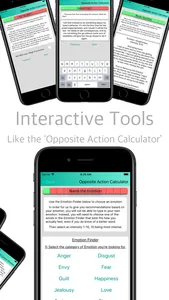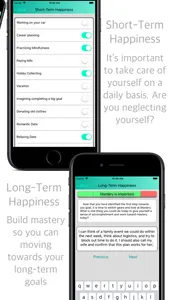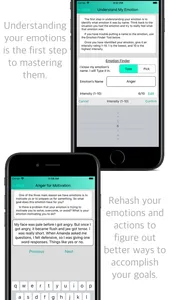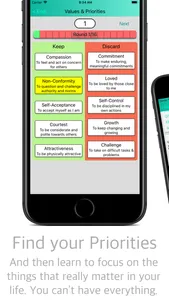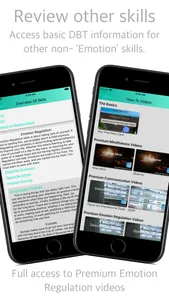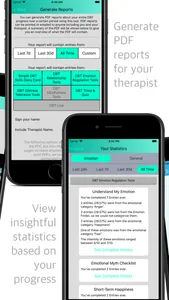Emotion Regulation Skills are meant to:
- Stop Unwanted Emotions from happening in the first place
- Stop or Reduce Unwanted Emotions once they start
How this app will help you:
Like all our 'Tools' apps, we'll start you off with a description of what DBT is. While DBT is a set of skills, there is also a sort of culture around it. And a way of teaching/learning it. Getting an overview of what DBT is, you can easily see where the skills fit in, and where you can most effectively integrate them into your day-to-day.
Then we'll go over the 7 DBT Emotional Regulation skills:
• Describe Emotions
• Opposite Action
• Problem Solving
• Accumulate Positives
• Build Mastery, Cope Ahead
• PLEASE
• Mindfulness of Current Emotion
Finally, we'll start you off using the Interactive Tools:
• Understand My Emotion: A common thought is that we feel some way for no reason at all. But did you know that ALL emotions have a reason behind them? Not only that, but they have a specific purpose. The stronger the emotion, the more you should probably look at it. Typically though, there are 3 main reasons:
A) To Motivate Us,
B) To Communicate to Others,
C) To Give Ourself Information
Use this tool to help make sense of your emotions. Even if you dislike how you feel, there is a good reason for how you feel. By understanding why we feel the way we do, we can adjust our trajectory to more effectively improve our situation.
• Emotional Myth Checklist: A common list of beliefs we may have about ourselves or the world we live in. Use this checklist to look more realistically at yourself. And then evaluate if you have these beliefs. By reducing the number of these that you have, you will be empowering yourself.
• Short-Term Happiness: Learn the importance of short-term happiness and how it actually has a great influence on your long-term happiness as well. Then use this tool to help you increase the number of daily positives in your life. You shouldn't live for the short-term, but neither should you live for the long-term.
• Long-Term Happiness: The opposite of Short-Term Happiness, Long-Term happiness cannot be neglected either. Use this tool to help you identify realistic goals, start them, and get the ball rolling.
• Observe & Describe Emotion: Did you know that Emotions are like the wind? They come and go, and will continue to come and go. Sometimes strong, or just a breeze. Sometimes none at all. But they keep coming. By seeing your emotions for what they are, your brain will give you a sense of calm. Use this tool to help you see Emotions for what they are. Not only can it help to deflate negative emotions, but by doing this, we can keep ourselves on track with being our best self.
• Opposite Action Calculator: If you've ever tried Opposite Action, you know it's not intuitive. Use this tool to prep for stressful situations or do Opposite Action on the spot.
• Values & Priorities: This is a tool to help you go through dozens of common Values & Priorities in your life and figure out which are most important. Ever feel like you're wasting your life doing things you don't want to be doing? This is the tool for you. Use it to help align what you do with what is most important.
• My PLEASE Status: These are the skills that your parents probably taught you that as an adult you may completely overlook. Use this tool to help check up on the basics.
Many of these tools are powerful while you're first learning DBT. But they are also incredibly powerful as a refresher. Beginners and Advanced DBT practitioners will find value in this app now, and for years to come.
* Note that this app can integrate with the Health App by adding 'Mindful Minutes' when you complete Opposite Action Calculator' and 'Understand My Emotion' entries. This is optional.
- Stop Unwanted Emotions from happening in the first place
- Stop or Reduce Unwanted Emotions once they start
How this app will help you:
Like all our 'Tools' apps, we'll start you off with a description of what DBT is. While DBT is a set of skills, there is also a sort of culture around it. And a way of teaching/learning it. Getting an overview of what DBT is, you can easily see where the skills fit in, and where you can most effectively integrate them into your day-to-day.
Then we'll go over the 7 DBT Emotional Regulation skills:
• Describe Emotions
• Opposite Action
• Problem Solving
• Accumulate Positives
• Build Mastery, Cope Ahead
• PLEASE
• Mindfulness of Current Emotion
Finally, we'll start you off using the Interactive Tools:
• Understand My Emotion: A common thought is that we feel some way for no reason at all. But did you know that ALL emotions have a reason behind them? Not only that, but they have a specific purpose. The stronger the emotion, the more you should probably look at it. Typically though, there are 3 main reasons:
A) To Motivate Us,
B) To Communicate to Others,
C) To Give Ourself Information
Use this tool to help make sense of your emotions. Even if you dislike how you feel, there is a good reason for how you feel. By understanding why we feel the way we do, we can adjust our trajectory to more effectively improve our situation.
• Emotional Myth Checklist: A common list of beliefs we may have about ourselves or the world we live in. Use this checklist to look more realistically at yourself. And then evaluate if you have these beliefs. By reducing the number of these that you have, you will be empowering yourself.
• Short-Term Happiness: Learn the importance of short-term happiness and how it actually has a great influence on your long-term happiness as well. Then use this tool to help you increase the number of daily positives in your life. You shouldn't live for the short-term, but neither should you live for the long-term.
• Long-Term Happiness: The opposite of Short-Term Happiness, Long-Term happiness cannot be neglected either. Use this tool to help you identify realistic goals, start them, and get the ball rolling.
• Observe & Describe Emotion: Did you know that Emotions are like the wind? They come and go, and will continue to come and go. Sometimes strong, or just a breeze. Sometimes none at all. But they keep coming. By seeing your emotions for what they are, your brain will give you a sense of calm. Use this tool to help you see Emotions for what they are. Not only can it help to deflate negative emotions, but by doing this, we can keep ourselves on track with being our best self.
• Opposite Action Calculator: If you've ever tried Opposite Action, you know it's not intuitive. Use this tool to prep for stressful situations or do Opposite Action on the spot.
• Values & Priorities: This is a tool to help you go through dozens of common Values & Priorities in your life and figure out which are most important. Ever feel like you're wasting your life doing things you don't want to be doing? This is the tool for you. Use it to help align what you do with what is most important.
• My PLEASE Status: These are the skills that your parents probably taught you that as an adult you may completely overlook. Use this tool to help check up on the basics.
Many of these tools are powerful while you're first learning DBT. But they are also incredibly powerful as a refresher. Beginners and Advanced DBT practitioners will find value in this app now, and for years to come.
* Note that this app can integrate with the Health App by adding 'Mindful Minutes' when you complete Opposite Action Calculator' and 'Understand My Emotion' entries. This is optional.
Show More
